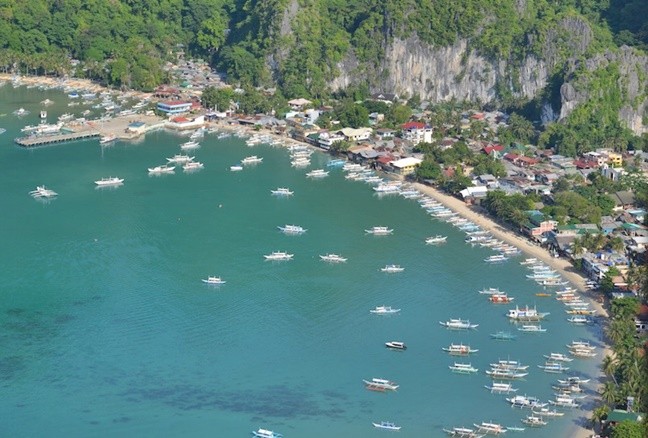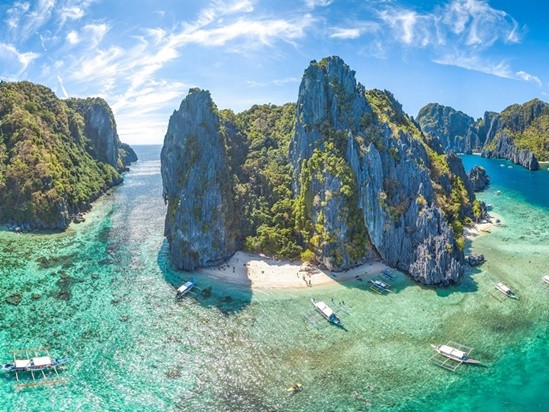Welcome to a delightful journey as we explore the 10 largest islands in the Philippines, each unique and rich in natural beauty and cultural heritage. This archipelago, composed of more than 7,000 islands, is renowned for its stunning landscapes, biodiversity, and vibrant cultures. The Philippines is not only a tropical paradise but also a country with diverse and abundant resources.
We will dive into the heart of the Philippines, venturing from the idyllic beaches of Palawan to the bustling streets of Luzon. Each island has its own tale to tell, echoing the rich history, traditions, and spirit of the Filipino people. This voyage through the largest islands in the Philippines is sure to captivate you, stirring a sense of wonder and deepening your appreciation for this remarkable country.
10 Largest Islands in the Philippines
So, sit back, relax, and let’s embark on this virtual tour to discover the distinctive charm of each of these 10 Largest Islands in the Philippines.
10. Bohol: An Exquisite Blend of Natural Wonders and Cultural Heritage (3,821 km2)

Immerse yourself in the magic of Bohol, the 10th largest island in the Philippines, a land of incredible natural beauty and rich history. Unfolding across 3,821 square kilometers, Bohol boasts over 162 miles of coastline, home to picturesque coral reefs, breathtaking waterfalls, and mystical caves. Within this verdant paradise, mischievous tarsier monkeys frolic amidst the island’s unique limestone formations, the Chocolate Hills, painting a tableau of life in perfect harmony with nature.
Yet, the allure of Bohol doesn’t stop at its natural splendors. The island is renowned for its quaint stone churches, testaments to the island’s cultural heritage. These architectural gems, nestled in the island’s lush landscapes, serve as a living history of the island’s captivating past.
Adding to its charm, Bohol is surrounded by over 70 satellite islands, each offering a unique experience and waiting to be discovered. No matter what brings you here, be it the enchanting wildlife, the captivating history, or the promise of adventure in the satellite islands, Bohol is sure to leave a lasting impression.
9. Cebu: The Queen of the South (4,468 km2)

Crowned the ‘Queen of the South,’ Cebu is a magnificent island paradise stretching for over 120 miles from top to bottom. The largest island in the Visayas region, Cebu’s dramatic coastlines, stunning beaches, and coral atolls paint a picture of tropical beauty that leaves visitors in awe.
Cebu is not just a feast for the eyes; it’s a hub of vibrant activity and cultural richness. Home to over 3.5 million people, the island perfectly blends developed areas with untouched natural beauty. Cebu City, the island’s bustling heart, is an intriguing mix of Spanish colonial history and modern Filipino lifestyle.
But Cebu is more than its city. It’s a collection of hundreds of smaller islands, each with its own charm. As you explore this tropical paradise, you’ll find pockets of tranquility and untouched beauty that echo the island’s history as the 17th-century country capital.
8. Leyte: From Historic Battlefields to Tranquil Farmlands (7,368 km2)

Leyte, the eighth largest island in the Philippines, has a unique allure. Tucked away in the Camotes Sea, this island offers a glimpse into the country’s rich history and its people’s resilient spirit. Leyte is most famous for the four-day-long Battle of the Leyte Gulf during World War II, the largest naval battle in history, reminding visitors of the island’s strategic importance.
Today, the echoes of the past have given way to the serene rhythms of agricultural life. Leyte has transformed into a peaceful farming country, with vast rice, corn, and coconut plantations spreading across the fertile Leyte Valley. The gentle rustling of the tobacco leaves in the breeze adds a distinctive charm to this pastoral landscape.
Yet, Leyte is not just about its past or its farmlands. The island is a treasure trove of natural beauty, waiting to be explored. Linked to the island of Samar by a massive bridge, Leyte invites you to lose yourself in the grandeur of its landscapes and the warmth of its people.
7. Mindoro: A Haven of Biodiversity and Untouched Beauty (10,572 km2)

Mindoro, the seventh-largest island in the Philippines, is an oasis of natural splendor nestled between Luzon and Palawan. Spread over 10,572 square kilometers, this island is home to over a million inhabitants and a vast array of unique wildlife. Mindoro’s most famous resident, the tamarau water buffalo, can be found nowhere else on Earth, making the island a must-visit for wildlife enthusiasts.
The island’s landscape is as diverse as its wildlife, with deep valleys giving way to white-sand beaches, meandering rivers, and tranquil lakes. Split into two provinces – Occidental Mindoro and Oriental Mindoro – the island offers a variety of experiences, each more captivating than the last.
Mindoro is a perfect escape for those seeking peace and tranquility. During the dry season, the island becomes a paradise for beach lovers, with its stunning coastlines providing the perfect backdrop for a memorable holiday.
6. Panay: The Gateway to the Visayas (12,011 km2)

Panay, the sixth-largest island in the Philippines, stands at the westernmost edge of the Visayas region. Home to nearly 4.5 million inhabitants, this triangular-shaped island is a vibrant blend of natural beauty and cultural richness.
Panay’s landscapes are adorned with mysterious caves and winding rivers, inviting exploration and adventure. Despite its beauty, the island often serves as a stepping stone for travellers heading to the more popular Boracay, famous for its White Beach. Yet, those who take the time to explore Panay will find an island full of charm and warmth, offering experiences as unforgettable as its more famous neighbour.
5. Palawan: The Last Ecological Frontier (12,189 km2)

Palawan, the largest island in its namesake province and the fifth-largest in the country, is a testament to the Philippines’ commitment to nature conservation. Often referred to as the ‘last ecological frontier’ of the Philippines, Palawan captivates with its unspoiled jungles, stunning beaches, and diverse wildlife.
Nestled between the South China Sea and the Sulu Sea, Palawan remains blissfully untouched by mass tourism. It’s a place where nature’s grandeur unfolds in all its glory, earning it the title of ‘most beautiful island in the world’ by Conde Nast Traveller and Travel + Leisure in 2016.
4. Negros: The Agricultural Heartland of the Philippines (13,310 km2)

Negros, the boot-shaped fourth-largest island in the Philippines, is a testament to the country’s agricultural riches. With over 100 miles of coastline to explore, Negros is a land of abundant resources and captivating beauty.
The island is known for its vast sugarcane plantations and sugar mills, which have made it one of the wealthiest regions in the country. Yet, the island’s bounty doesn’t end with sugar. Copper and coal mines, cornfields, rice paddies, and coconut groves dot the island, showcasing the diversity of its agricultural offerings.
Offshore, Negros offers some of the best diving experiences in the Philippines. The island’s coral gardens and underwater reefs teem with marine life, making it a paradise for divers and marine enthusiasts alike.
3. Samar: The Green Gem of the Visayas (13,429 km2)

Samar, the third-largest island in the Philippines, is a haven for nature lovers. Located at the eastern edge of the Visayas group, Samar is surrounded by the Samar Sea, the Philippine Sea, and the San Bernardino Strait. This lush island is characterized by scenic coastal plains and flood lands, offering a unique blend of natural beauty and biodiversity.
Situated at the eastern edge of the Visayas, Samar stands as a magnificent testament to the Philippines’ lush, verdant landscapes. This island, the third largest in the country, is a stunning showcase of untouched nature, punctuated by scenic coastal plains and flood lands. Often referred to as the “Green Gem of the Visayas”, Samar’s rich biodiversity and lush greenery are truly a sight to behold.
At the heart of Samar lies the Samar Island Natural Park, the Philippines’ largest connected section of old-growth forest. This protected area is a haven for wildlife and offers a glimpse into the country’s vibrant biodiversity. From the rustling leaves of towering trees to the melodic calls of rare bird species, a walk through this natural park feels like a symphony of nature’s best tunes.
Samar also has its share of historical significance. The island is connected to Leyte, its neighbor, by the San Juanico Strait, forming a significant link between the two major Visayan islands. Samar’s coastline, washed by the Samar Sea, the Philippine Sea, and the San Bernardino Strait, offers panoramic views that are nothing short of breathtaking. As you traverse the island, you’ll discover a land where history, nature, and culture intertwine, making Samar a truly remarkable destination in the archipelago of the Philippines.
2. Mindanao: The Pioneer Frontier (97,530 km2)

Mindanao, the second-largest island in the Philippines, is a treasure trove of cultural diversity and natural beauty. This unusually-shaped, massive mountainous island stretches nearly 300 miles from north to south and is surrounded by the Bohol, Celebes, Philippine, and Sulu seas.
The island is a volcanic marvel and home to the tallest peak in the country, Mount Apo. Its rich cultural tapestry includes the highest concentration of different ethnic minorities in the Philippines, including the Maranao, Maguindanao, and Sangil people.
Agriculture thrives in this fertile land, with vast fields of corn, rice, and various fruits. Coffee and cacao are also grown here, adding to the island’s rich agricultural bounty. Mindanao truly lives up to its nickname as the ‘pioneer frontier’.
1. Luzon: The Heart of the Philippines (109,965 km2)

Luzon, the largest and most populous island in the Philippines, is a vibrant blend of culture, history, and natural beauty. With a land area of 109,965 square kilometers, it’s not only the Philippines’ largest island but also the 15th largest island on the planet1.
Located in the northern Philippines, Luzon is the nation’s economic and political hub. Home to more than 50 million people, the island accounts for more than half of the Philippines’ total population.
Luzon’s landscapes are as diverse as its people, ranging from bustling cities to serene countryside, majestic mountains to pristine beaches. The island is a microcosm of the Philippines, offering a snapshot of the country’s rich cultural heritage and natural splendor.
Frequently Asked Questions
1. What are the largest islands in the Philippines?
The largest islands in the Philippines, by land area, are Luzon, Mindanao, Samar, Negros, Palawan, Panay, Mindoro, Leyte, Cebu, and Bohol.
2. Which is the most populated island in the Philippines?
Luzon is the most populated island in the Philippines, with over 50 million residents.
3. Which island in the Philippines is known as the ‘last ecological frontier’?
Palawan is often referred to as the ‘last ecological frontier’ in the Philippines due to its commitment to nature conservation.
4. What is unique about the wildlife on Mindoro?
Mindoro is home to the tamarau water buffalo, a species found nowhere else on Earth.
5. Which island in the Philippines is known for its agricultural wealth?
Negros is known for its vast sugarcane plantations and sugar mills, making it one of the wealthiest regions in the Philippines.
6. What are the 3 largest islands in the Philippines?
The three largest islands in the Philippines, by land area, are Luzon, Mindanao, and Samar. Luzon is the largest, followed by Mindanao and then Samar.
7. What is one of the largest islands in the Philippines?
Luzon is the largest island in the Philippines. It is the economic and political hub of the country and is home to more than half of the nation’s population.
8. What are the 5 biggest islands in the Philippines?
The five biggest islands in the Philippines, by land area, are Luzon, Mindanao, Samar, Negros, and Palawan.
9. What are the two largest Philippine islands?
The two largest islands in the Philippines are Luzon and Mindanao. Luzon is the largest, followed by Mindanao.
